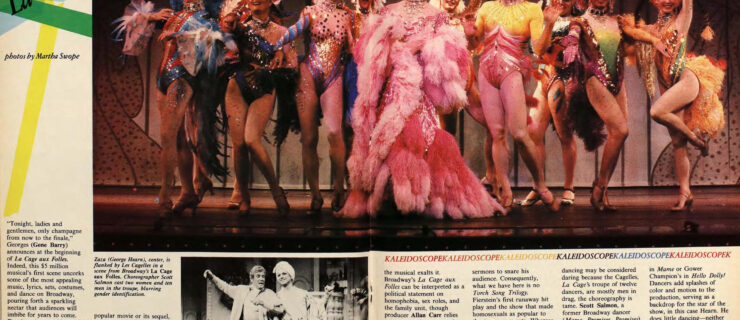How Can We Chip Away at the Shame Surrounding Mental Illness?
As a dancer going through a mental health challenge, loneliness can feel like your only companion. Pacific Northwest Ballet soloist Steven Loch has managed obsessive-compulsive disorder since middle school, and for nearly a decade felt too scared to speak up. “We feel like if we say something people will be horrified by some of the thoughts that we are having,” he says.
But according to the National Alliance on Mental Illness, one in five adults in the U.S. experiences a mental illness each year. Psychologists say that in competitive environments like the dance studio—where perfectionism can make you feel like you’re never good enough, and an injury can suddenly strip you of your identity—this likelihood may increase.
Last summer I shared my own story of quitting dance due to untreated depression on the Dance Magazine website. It was met with an outpouring of support and camaraderie that I found both affirming and terrifying. A few weeks later, the magazine published an online survey to learn more about dancer attitudes around the need for mental health support. Readers submitted more than 1,000 comments, demonstrating that these struggles are very much a shared experience.
So why do so few in the dance world talk about this openly? And what can be done to provide dancers with the support they need? No one’s arguing that the highly competitive, strenuous nature of dance is something that should change—that would compromise the excellence of the art form. But can we chip away at the shame surrounding mental health issues?
Let’s Stop Confusing Mental Illness With Being “Lazy” Or “Weak”
 Sharing our own struggles can help change the dance culture to be more open about mental illness. Photo by Joshua Rawson Harris/Unsplash
Sharing our own struggles can help change the dance culture to be more open about mental illness. Photo by Joshua Rawson Harris/Unsplash
In the dance field, acknowledging any kind of vulnerability is typically frowned upon. Dancers worry that teachers and directors assume they’re “lazy” when they’re struggling, or that they will be considered “weak” if they come forward to talk about it.
This isn’t surprising. Among the many symptoms of depression, the Mayo Clinic sites apathy, social isolation and fatigue. To the untrained eye, any of these can be confused with laziness—especially in a high-performance climate like a dance studio.
“There are still huge stigmas in dance culture, even to come in to do an open workshop on mindfulness meditation,” says Dr. Sharon Chirban, a psychologist who works with dancers at Boston Ballet.
The power to change this culture lies with teachers, ballet masters and directors—those who are in positions of influence among dancers. Dr. Brian Goonan, a sports psychologist who worked with dancers at the Houston Ballet Academy for nine years, says that teachers willing to share their own struggles can have a big impact. “All you have to do is make statements about how successful people have gotten help, and therefore it is okay for young dancers to do it,” he says.
From my personal experience, I’ve found that the majority of teachers do care, and wish they could help. But only 10 percent of dancers surveyed by Dance Magazine said that they would definitely feel comfortable reaching out to a teacher or director. Unfortunately, few artistic staff members have the resources to support their dancers’ mental well-being the way that they do physical injuries, because most dance institutions haven’t made it a priority.
We Need to Put More Into Preventative Medicine
 Elmhurst Ballet School students use an app to rate their mental wellness. Photo by Andrew Ross, courtesy Elmhurst
Elmhurst Ballet School students use an app to rate their mental wellness. Photo by Andrew Ross, courtesy Elmhurst
Over the last two decades, some large dance institutions have initiated relationships with mental health professionals. Yet progress has been slow. “Even the institutions doing a good job are doing crisis management,” says Chirban. Many psychologists lament that they only have limited access to the dancers, and are only brought in when there is already a problem.
There are models of preventive mental health measures that show cause for hope. At Elmhurst Ballet School in Birmingham, England, the school employs a mental health nurse and uses an app on the dancers’ phones asking them to regularly rate their mental and physical wellness on a 10-point scale. While the program was in its first year, initially, more than 70 percent of the students voluntarily used the tool, according to Nico Kolokythas, who is a performance enhancement coach for the school and developed the app.
Thanks to the data collection, Elmhurst assistant principal Annelli Peavot has been able to bring compelling arguments to their governing body about the need for preventive mental health intervention. On an individual level, the data can show that a student may need to be connected to services. “When we see that a student is reporting a low mood over time, even just going to them and saying that we noticed seems to have an effect,” says Peavot.
Realize That Investing in Mental Health Is Good for Business
 Ignoring the problem could mean losing dancers, students and audience members. Photo by Andrei Lazarev/Unsplash
Ignoring the problem could mean losing dancers, students and audience members. Photo by Andrei Lazarev/Unsplash
Everyone knows that in cash-strapped dance institutions it is a battle of priorities to stay afloat financially. Yet there’s an argument to be made that investing in mental health services can impact the bottom line. “A student in our program puts about £26,000 per year into the school,” says Peavot. “Can we really afford not to do it?” Those who quit take their £26,000 with them.
Likewise, companies rely on their dancers to present demanding repertoire and stay healthy in order to succeed. But symptoms like fatigue, lack of sleep and poor eating habits heighten a dancer’s likelihood of injury and decrease their ability to perform to their full potential.
Ticket sales should also be considered. A 2010 WolfBrown study of dance audiences commissioned by Dance/USA found that more than 50 percent of audience members are current or former dancers. So who is missing? For more than four years following my time in dance, I struggled to walk into a theater. I have a daughter, who I am deeply resistant to enrolling in a dance school. These are dollars lost. And there must be so many more.




